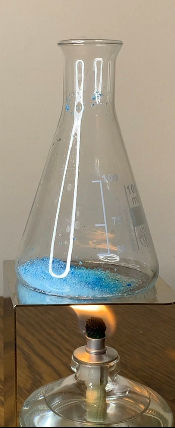Reversible Chemical Reactions
- Positive Reactions
- Oct 18, 2021
- 2 min read
Updated: Mar 21, 2022

In this experiment we showcase reversible chemical reactions by decomposing blue Copper Sulfate Pentahydrate into white Copper Sulfate and then reforming Copper Sulfate Pentahydrate by adding water
Difficulty: Easy
Materials:
Copper Sulfate Pentahydrate (available in home depot as Zep Root Killer)
Erlenmeyer flask
Spirit Lamp or another way to heat the test Tube
Procedure:
Take a little Copper Sulfate Pentahydrate in a Erlenmeyer flask and heat it over fire
2. You can observe the crystals slowly losing color till it is completely white.
3.Let the flask cool a little and then add some water to the white powder
4. We can see the solution turning back to blue in color since Copper Sulphate Pentahydrate is reformed
5. The solution can be heated again and will turn white again. This experiment can be repeated many times( hence called reversible). Here is a video on this experiment
How It Works:
In a reversible chemical reaction, the products can be changed back into the original reactants. In theory, all chemical reactions can be reversible , but that is not always the case. For example, neutralization reactions are not reversible.
The blue Copper Sulphate is referred to as hydrated. Hydrated means it contains water off crystallization, which can be removed by by heating strongly. The Copper ions in the crystal lattice structure of Copper Sulphate are surrounded by water molecules.
When the blue Copper Sulphate is heated, the water evaporates leaving behind the anhydrous (contains no water) white Copper Sulphate.
The equation is as shown below. Note the half arrows pointing both sides indicating that the equation is reversible

When water is added to the anhydrous Copper Sulphate, it will bind back to the Copper ions giving hydrated blue Copper Sulphate. This experiment can be repeated many times since it is reversible.



Comments